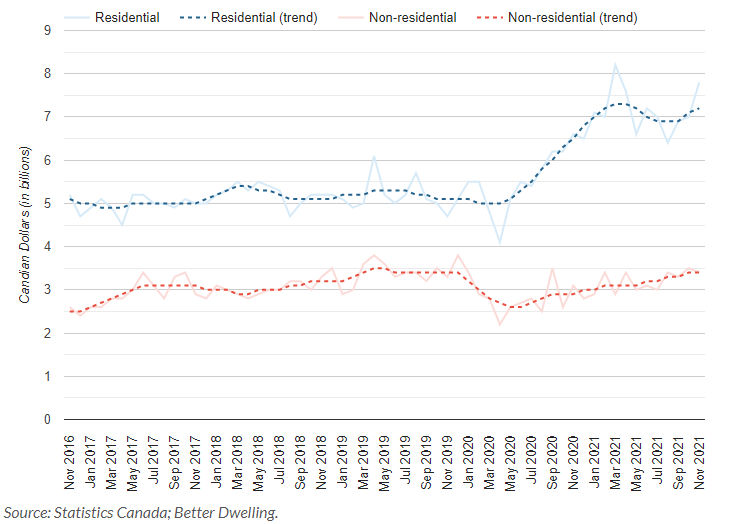
Canadian real estate has outgrown productive investment, and it’s not slowing down. Statistics Canada (Stat Can) data shows building permits, considered a leading indicator for future building intentions, climbed in November. The growth is entirely attributed to home building, now running 50% above pre-2020. More housing is nice, but Canada is already sinking more investment into housing than businesses. The acceleration of this trend shows it’s not even considering a slow down.
Canadian Building Intentions Have Increased 7%
The total of building permits made a sharp increase in the latest data. Building permits reached $11.2 billion in November, up 6.8% seasonally adjusted from a month before. In current dollars, this is a new record high and bucks the pre-election slowdown that was brewing.
Building intentions are still high when adjusted for inflation, but it trims a lot of the growth. In November, real values increased 6.3% from the month before. Shaving off 50 basis points (bps) of growth is nothing to sneeze at. Instead of a record high, building permits are down 7.1% from March 2021, in real terms. It’s a lot of inflation in the system, especially in the monthly increase.
Housing Is Now Seeing 50% More Investment Than Pre-Pandemic
Residential building permit values are rising, an indicator of increasing homebuilding intentions. The sector saw $7.8 billion in permits for November, up 12% from a month before. It was the biggest month since March 2021.
Canadian Future Building Intentions
The seasonally adjusted value of Canadian residential and non-residential building permits, and their respective trendlines.

There’s a LOT of housing in the pipeline. As you can see in the chart above, the run rate for residential building is nearly 50% higher than pre-2020. It wasn’t particularly slow going into 2020 either, with cities like Toronto topping global building charts. Home prices soaring (and subsidies to drive prices higher) are creating a lot of incentive to build.
Non-Residential Building Intentions Are Falling
Apparently, these homes don’t require schools, malls, hospitals, or government infrastructure. No one’s building non-residential structures at this time. Non-residential building intentions fell to $3.4 billion in November, down 2.9% from a month before. While this is trending higher than 2020, it hasn’t changed much since 2019. The trend has been relatively consistent over the past half-decade.
Future building intentions are rising, but it’s exclusively a trend for residential housing. Canada needs more housing, but everyday it gets closer to an economy that just builds houses. Investment is already heavily concentrated in real estate. November’s data shows the country is heading even further down this path. Households see few things to invest in other than housing, absorbing more capital than business machinery.
Source: betterdwelling.com
Posted by Teri-Lynn Jones on
Leave A Comment